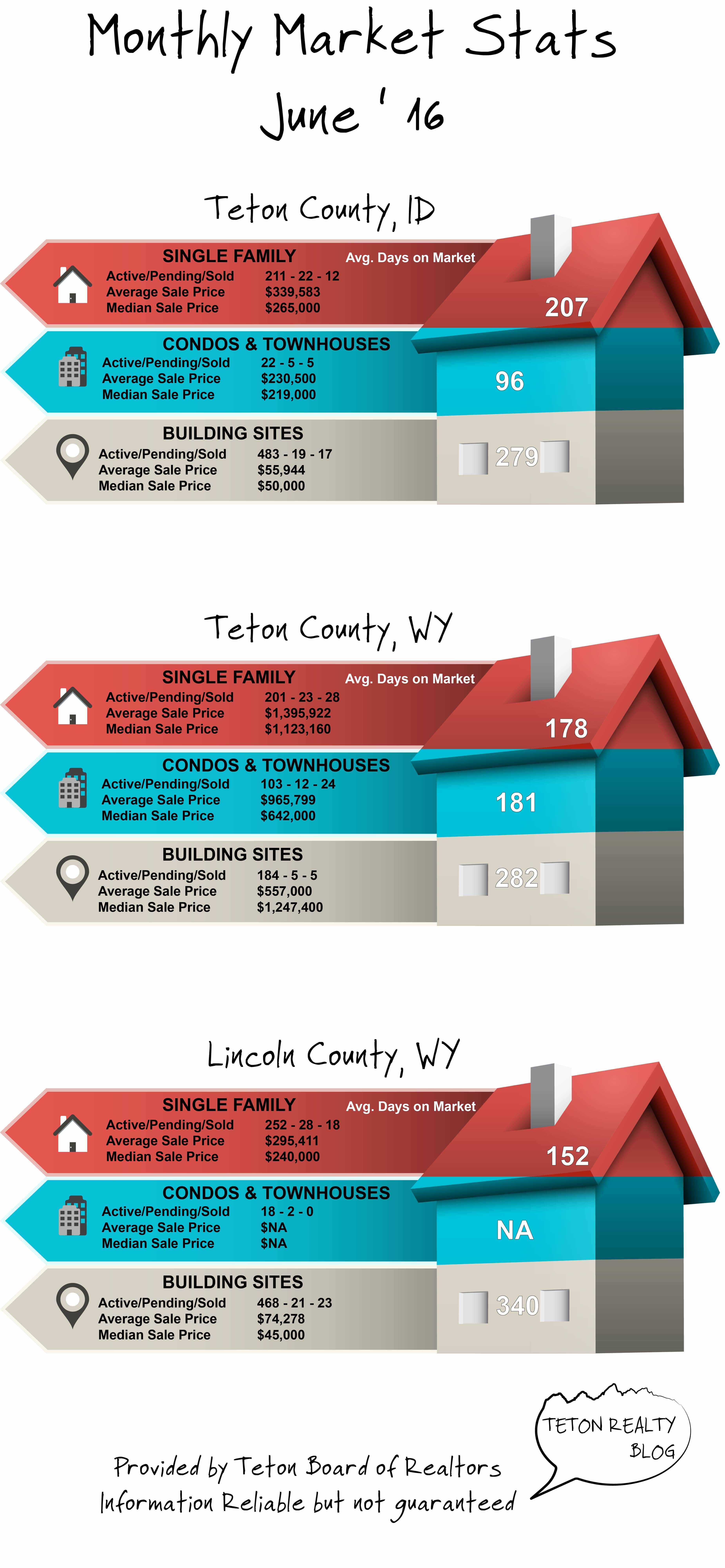 Alright, so we been hearing about it for months, and there are those of us that have been intimately involved in understanding the issue, and resolving it. For those of us that have not, a simplified understanding, below. ***Do not rely on this post for building eligibility matters, refer to Teton County Planning & Zoning for questions and/or accuracy, http://www.tetoncountyidaho.gov/department.php?deptID=18&menuID=1
Alright, so we been hearing about it for months, and there are those of us that have been intimately involved in understanding the issue, and resolving it. For those of us that have not, a simplified understanding, below. ***Do not rely on this post for building eligibility matters, refer to Teton County Planning & Zoning for questions and/or accuracy, http://www.tetoncountyidaho.gov/department.php?deptID=18&menuID=1
June ’16 Market Stats
Average sale prices continue to increase when compared to 12 months ago in almost every sector in Teton County Idaho, Wyoming, and Lincoln County Wyoming. Believe it or not, inventory is also up from last year, and up a fair percentage from last month. Number of sales have have increased from 12 months ago, but have decreased from last month. This could be an indication that listing prices have exceeded what buyers are willing to pay, though I feel this is simply a small adjustment in our evolving market, and list prices as well as average sales prices will continue to rise, specifically with lot sales.

Buyer & Seller Tips – Be Nice!
 We all read tips and tricks from various real estate blog posts, websites, and other forms of marketing. These can be pricing structures, things to look for in your home inspection, how to negotiate in certain markets, and so on.
We all read tips and tricks from various real estate blog posts, websites, and other forms of marketing. These can be pricing structures, things to look for in your home inspection, how to negotiate in certain markets, and so on.
One bit of advice I don’t see you come up very often is simply being courteous, and easy to work with. I don’t necessarily mean professional, we should always be professional and ethical. I see scenarios come about all the time that could be easily resolved if both parties were easier to work with one another. You don’t have to like the buyer or seller on the other end of the transaction, and I hate to put it this way, but sometimes you just need to act like you do. Sometimes they are likeable. Sometimes it comes naturally, but oftentimes not.
A few examples;
A buyer is looking at a hot home priced right, being shown frequently. The seller takes great pride of ownership, and owns a well-maintained home with trendy furnishings. Knowing that the home will sell quickly, it would be a consideration for the buyer to be appreciative and respectful. Sellers who are attached to their home are more inclined to work with a buyer who they think will appreciate it. Now is not the time to ask for furnishings, or un-ordinary contingencies. I’ve been in several situations where I have written successful transactions simply by watching the way I word things in the contract, and coaching the buyer on things he or she shouldn’t be asking for. In this scenario, the seller could have easily waited for multiple offers or a higher price, but the seller felt comfortable with the buyer whom by all appearances would be a great new owner.
On the seller’s side, being courteous can be advantageous as well. I have had several situations with sellers who have received multiple offers. There have been circumstances where one offer was clearly above the rest, but the seller still felt it necessary to request multiple offers and give a stringent deadline. Now, there are situations where I advise multiple offer situations on behalf of the seller. However, in this circumstance the buyer in particular with the highest and best offer withdrew, “not wanting to get into a bidding war”. In some regards this communication is delivered through the representing agent or broker, so it’s important to express these feelings to the agent to convey to the opposite end of the transaction. Oftentimes a pushy buyer or seller with unreasonable requests will come through in the agents negotiation whether or not that was the intent.
I might be pushing it with this one, but I personally think it helps to have a courteous relationship between an agent and customer or client. Oftentimes buyers want to see everything available on the market whether that’s 3 or 30 homes in their price range. Without a representation agreement with a buyer, an agent holds an element of concern that customer ultimately work with another broker after many hours or days to weeks of time spent. Expressing appreciation and reassurance is an excellent tool to help that buyer agent relationship and also insure that agent will continue to work diligently on behalf of the customer. The same goes for the seller. I have seen several instances where sellers are clearly the market experts, (Isay this sarcastically) even more so than the agent. They can demand unreasonable marketing requests that will not perform, and are not interested in hearing that agent’s opinion of those marketing avenues. Being appreciative of efforts that agent is making, and even making suggestions can instill not only confidence, but an element of drive to complete the task diligently.
We all know what it means when an agent is ethical, but not necessarily courteous to the public. It can damage that agents reputation, and pocketbook. It is however often overlooked on the opposite end of the spectrum.
Where do listings come from? How will list hub’s termination affect Zillow?
Yes, this is another one of those posts explaining how listings are born, then appear on websites like Zillow and realtor.com. With several new changes to the internet web platforms in recent years, I thought it might be a good time to update this post.
First, a refresher on how listings are born.
Each listing you see online was created by a real estate agency, and typically one agent within an agency. A seller agrees to list a property for sale with that agent, and that agent uploads it to what is called the multiple listing service in most cases.
***The multiple listing service is a database where information about properties is stored, including the ability for agents with other agencies to cooperate with one another, understand how the agents are compensated, and provide information to appraisers (amongst other things).
There is not just one multiple listing service, and there is not a method to the madness in terms of what MLS system an agent uses. There are approximately 1,400 Multiple List Services operated by a local real estate association across the country. For example, the Teton Board of Realtors operates the Teton MLS which covers a bit of East Idaho and Western Wyoming. The Idaho Falls Association of Realtors operates the Snake River MLS and covers most of Eastern Idaho except for Teton County. You start to get the idea, even Phoenix has two multiple listing services that serve the city because there are so many properties for sale. (ever see duplicate listings online? This is because an agent uploaded the same listing to two MLS’s) Each listing in these MLS databases is then sent to, or syndicated with another website. Historically this has been done through a company called List Hub which is a syndication service. List Hub would gather the information from each MLS, and provide a feed to sites like Trulia and Zillow. So, listings are created by an agent, entered into an MLS, that information is then distributed to other web platforms.
Anyway, back to the latest news;
The first major change we saw recently was Zillow group’s acquisition of Trulia. You probably won’t notice too much of a difference on the customer end, but all of us agents now work on one platform for both web sites. Agent profile pages, reviews, all took a hit because of this. If you have had the question in years past which is better or more accurate in terms of Zillow or Trulia, I would say the same at this time. Continue to use whichever site you are more comfortable with.
In even bigger news, we saw a fairly drastic change in the world of News Corp, who owns Move, Inc. You may not know who Move is, but they operate realtor.com which is directly related to the National Association of Realtors. Move also owns the syndication platform mentioned above, List Hub. Knowing that realtor.com and Zillow are competitors, Move made a sharp decision in January of this year to stop supplying feeds from List Hub to the Zillow group. In a hearing in February a judge granted another month of data from List Hub to the Zillow group. Without that preparation time for the Zillow group, we likely would have seen Zillow lose several hundred thousand listings online. Without List Hub, the alternative for companies like the Zillow group was to contact each multiple listing service and request a feed directly from them. In many cases, we found that local MLS boards contacted the Zillow group directly to insure the listings would not be lost on these websites. Such is the case with our Teton MLS, which is why you continue to see local listings on these web sites.
Nationally, it is my opinion that because of this independent brokerage websites and realtor.com are the most reliable source for listing accuracy. It is unlikely that there are very many multiple listing services that are not providing data to sites or companies like the Zillow group, but it is likely that there will remain a few for years to come.
